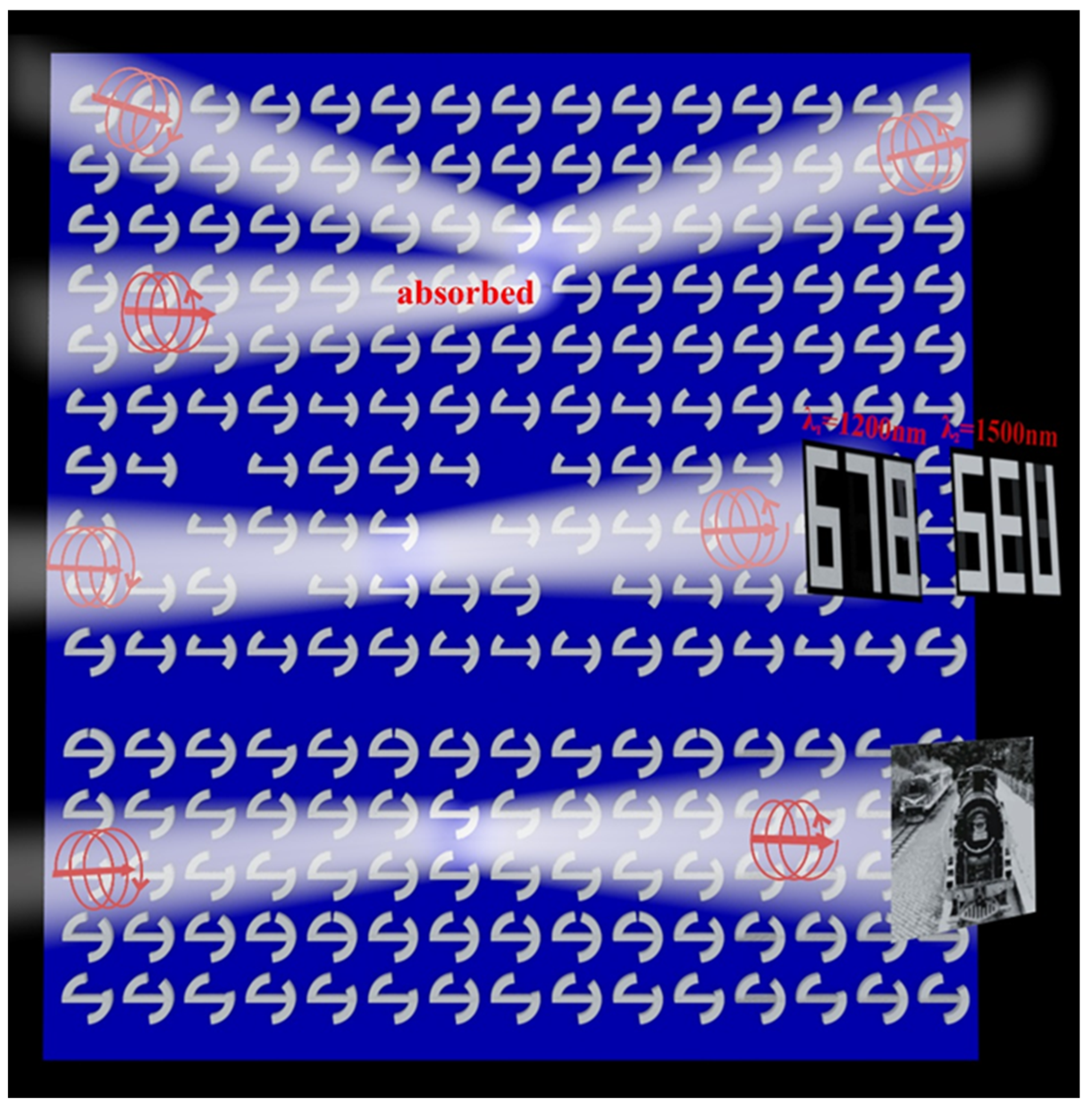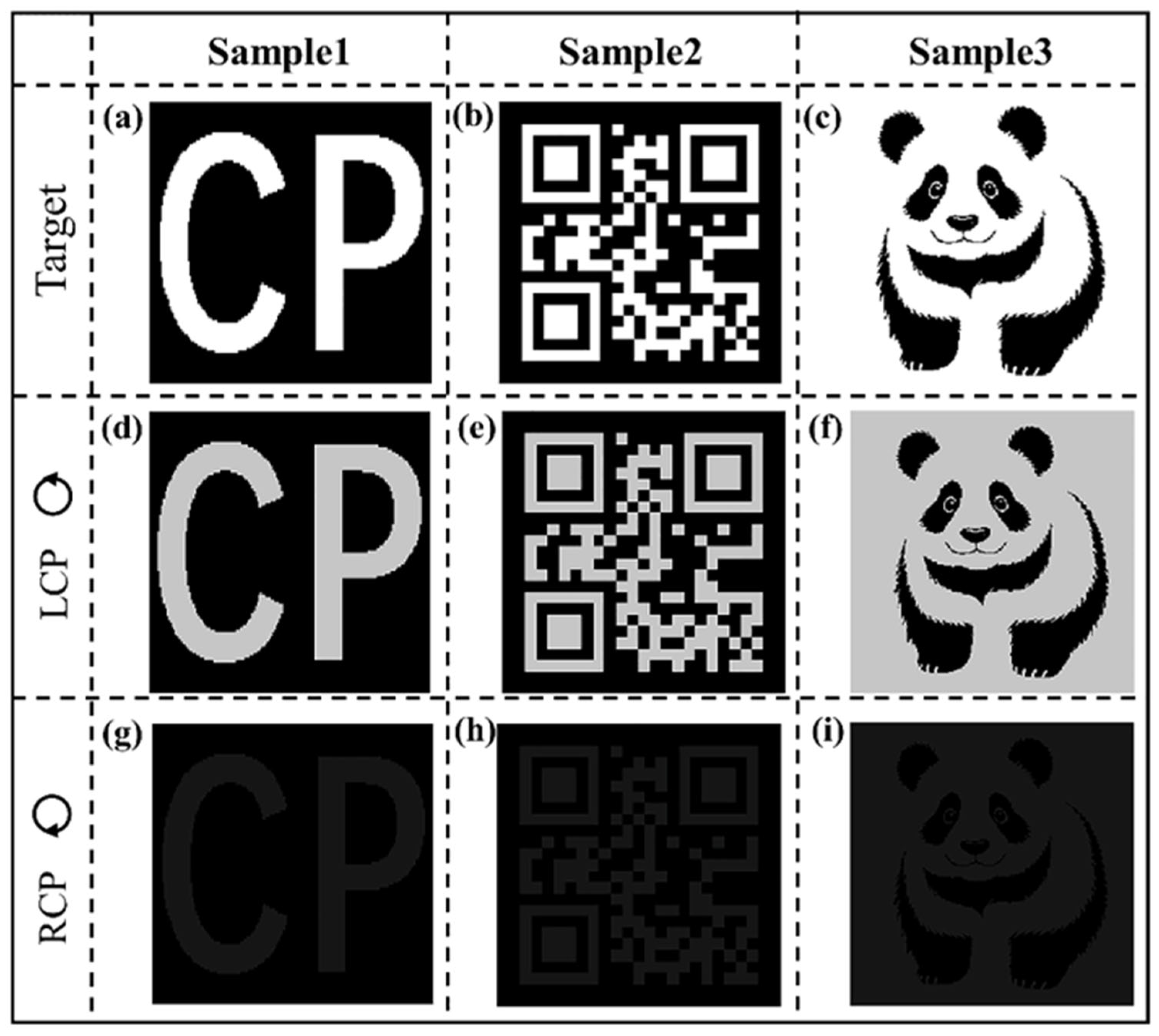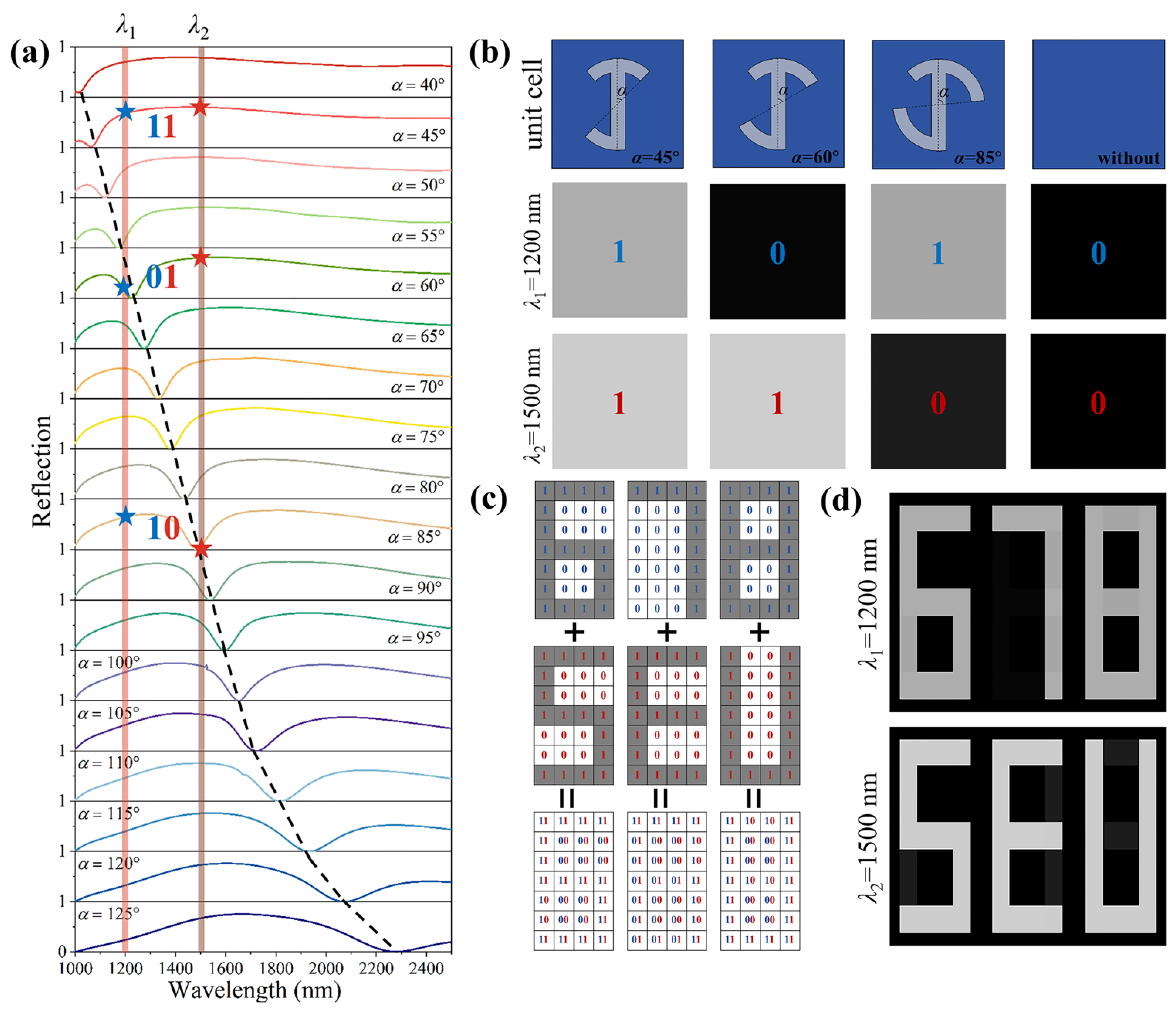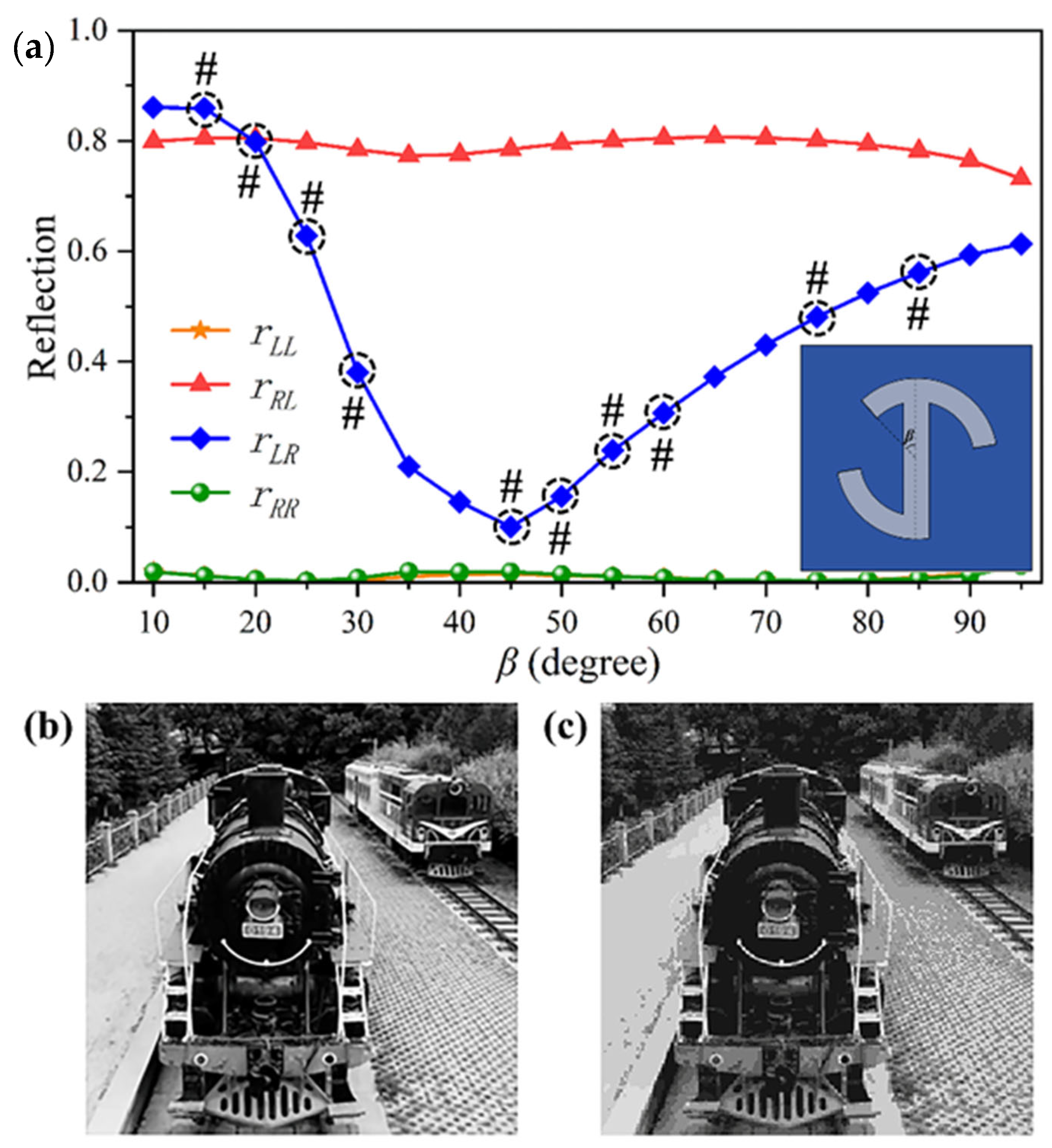Chiral Grayscale Imaging Based on a Versatile Metasurface of Spin-Selective Manipulation
Abstract
1. Introduction
2. Materials and Methods
3. Results
4. Discussion
5. Conclusions
6. Numerical Characterizations
Supplementary Materials
Author Contributions
Funding
Institutional Review Board Statement
Informed Consent Statement
Data Availability Statement
Conflicts of Interest
References
- Kim, J.; Oh, D.K.; Kim, H.; Yoon, G.; Jung, C.; Kim, J.; Badloe, T.; Kang, H.; Kim, S.; Yang, Y.; et al. Metasurface Holography Reaching the Highest Efficiency Limit in the Visible via One-Step Nanoparticle-Embedded-Resin Printing. Laser Photonics Rev. 2022, 16, e2200098. [Google Scholar] [CrossRef]
- Deng, Z.L.; Jin, M.; Ye, X.; Wang, S.; Shi, T.; Deng, J.; Mao, N.; Cao, Y.; Guan, B.O.; Alù, A.; et al. Full-Color Complex-Amplitude Vectorial Holograms Based on Multi-Freedom Metasurfaces. Adv. Funct. Mater. 2020, 30, e1910610. [Google Scholar] [CrossRef]
- Lee, G.Y.; Yoon, G.; Lee, S.Y.; Yun, H.; Cho, J.; Lee, K.; Kim, H.; Rho, J.; Lee, B. Complete Amplitude and Phase Control of Light Using Broadband Holographic Metasurfaces. Nanoscale 2018, 10, 4237–4245. [Google Scholar] [CrossRef] [PubMed]
- Zhou, H.; Li, X.; Xu, Z.; Li, X.; Geng, G.; Li, J.; Wang, Y.; Huang, L. Correlated Triple Hybrid Amplitude and Phase Holographic Encryption Based on a Metasurface. Photonics Res. 2022, 10, 678–686. [Google Scholar] [CrossRef]
- Jang, J.; Lee, G.Y.; Sung, J.; Lee, B. Independent Multichannel Wavefront Modulation for Angle Multiplexed Meta-Holograms. Adv. Opt. Mater. 2021, 9, e2100678. [Google Scholar] [CrossRef]
- Jin, R.; Deng, L.; Tang, L.; Cao, Y.; Liu, Y.; Dong, Z.-G. Decoupled Phase Modulation for Circularly Polarized Light via Chiral Metasurfaces. ACS Photonics 2022, 10, 155–161. [Google Scholar] [CrossRef]
- Jin, L.; Dong, Z.; Mei, S.; Yu, Y.F.; Wei, Z.; Pan, Z.; Rezaei, S.D.; Li, X.; Kuznetsov, A.I.; Kivshar, Y.S.; et al. Noninterleaved Metasurface for (26−1) Spin- and Wavelength-Encoded Holograms. Nano Lett. 2018, 18, 8016–8024. [Google Scholar] [CrossRef]
- Guo, X.; Zhong, J.; Li, B.; Qi, S.; Li, Y.; Li, P.; Wen, D.; Liu, S.; Wei, B.; Zhao, J. Full-Color Holographic Display and Encryption with Full-Polarization Degree of Freedom. Adv. Mater. 2021, 34, e2103192. [Google Scholar] [CrossRef]
- Hao, J.; Ma, T.; Ye, Z.; Chen, C.; Yang, D.; Zhou, K.; Wang, Y.; Jin, P.; Lin, J. Simulation for Multiwavelength Large-Aperture All-Silicon Metalenses in Long-Wave Infrared. Nanotechnology 2022, 33, e225203. [Google Scholar] [CrossRef]
- Zhang, S.; Huang, L.; Geng, G.; Li, J.; Li, X.; Wang, Y. Full-Stokes Polarization Transformations and Time Sequence Metasurface Holographic Display. Photonics Res. 2022, 10, 1031–1038. [Google Scholar] [CrossRef]
- Li, N.; Chen, H.; Zhao, Y.; Wang, Y.; Su, Z.; Liu, Y.; Huang, L. Ultrasensitive Metasurface Sensor Based on Quasi-Bound States in the Continuum. Nanophotonics 2025, 14, 485–494. [Google Scholar] [CrossRef] [PubMed]
- Montelongo, Y.; Tenorio-Pearl, J.O.; Milne, W.I.; Wilkinson, T.D. Polarization Switchable Diffraction Based on Subwavelength Plasmonic Nanoantennas. Nano Lett. 2014, 14, 294–298. [Google Scholar] [CrossRef]
- Yao, B.; Zang, X.; Zhu, Y.; Yu, D.; Xie, J.; Chen, L.; Han, S.; Zhu, Y.; Zhuang, S. Spin-Decoupled Metalens with Intensity-Tunable Multiple Focal Points. Photonics Res. 2021, 9, 1019–1032. [Google Scholar] [CrossRef]
- Britton, W.A.; Chen, Y.; Sgrignuoli, F.; Dal Negro, L. Compact Dual-Band Multi-Focal Diffractive Lenses. Laser Photonics Rev. 2021, 15, e2000207. [Google Scholar] [CrossRef]
- Yuan, H.; Tang, W.; Zhong, Z.; Zhang, B. Crosstalk-Avoided 3D Full-Color Holographic Displays Enabled by Single-Cell Metasurfaces. Photonics Res. 2025, 13, 235–248. [Google Scholar] [CrossRef]
- Zheng, G.; Mühlenbernd, H.; Kenney, M.; Li, G.; Zentgraf, T.; Zhang, S. Metasurface Holograms Reaching 80% Efficiency. Nat. Nanotechnol. 2015, 10, 308–312. [Google Scholar] [CrossRef] [PubMed]
- Fu, R.; Shan, X.; Deng, L.; Dai, Q.; Guan, Z.; Li, Z.; Zheng, G. Multiplexing Meta-Hologram with Separate Control of Amplitude and Phase. Opt. Express. 2021, 29, 27696–27707. [Google Scholar] [CrossRef]
- Cao, Y.; Tang, L.; Li, J.; Lee, C.; Dong, Z.-G. Four-Channel Display and Encryption by Near-Field Reflection on Nanoprinting Metasurface. Nanophotonics 2022, 11, 3365–3373. [Google Scholar] [CrossRef]
- Li, Z.; Liu, W.; Cheng, H.; Choi, D.Y.; Chen, S.; Tian, J. Arbitrary Manipulation of Light Intensity by Bilayer Aluminum Metasurfaces. Adv. Opt. Mater. 2019, 7, e1900260. [Google Scholar] [CrossRef]
- Ahmed, H.; Intaravanne, Y.; Ming, Y.; Ansari, M.A.; Buller, G.S.; Zentgraf, T.; Chen, X. Multichannel Superposition of Grafted Perfect Vortex Beams. Adv. Mater. 2022, 34, e2203044. [Google Scholar] [CrossRef]
- Dai, Q.; Li, Z.; Deng, L.; Zhou, N.; Deng, J.; Tao, J.; Zheng, G. Single-Size Nanostructured Metasurface for Dual-Channel Vortex Beam Generation. Opt. Lett. 2020, 45, 3773–3776. [Google Scholar] [CrossRef] [PubMed]
- Zheng, C.; Li, J.; Liu, J.; Li, J.; Yue, Z.; Li, H.; Yang, F.; Zhang, Y.; Zhang, Y.; Yao, J. Creating Longitudinally Varying Vector Vortex Beams with an All-Dielectric Metasurface. Laser Photonics Rev. 2022, 16, e2200236. [Google Scholar] [CrossRef]
- Deng, J.; Deng, L.; Guan, Z.; Tao, J.; Li, G.; Li, Z.; Li, Z.; Yu, S.; Zheng, G. Multiplexed Anticounterfeiting Meta-Image Displays with Single-Sized Nanostructures. Nano Lett. 2020, 20, 1830–1838. [Google Scholar] [CrossRef]
- Li, Z.; Chen, C.; Guan, Z.; Tao, J.; Chang, S.; Dai, Q.; Xiao, Y.; Cui, Y.; Wang, Y.; Yu, S.; et al. Three-Channel Metasurfaces for Simultaneous Meta-Holography and Meta-Nanoprinting: A Single-Cell Design Approach. Laser Photonics Rev. 2020, 14, e2000032. [Google Scholar] [CrossRef]
- Cao, Y.; Tang, L.; Li, J.; Wang, J.; Dong, Z.G. Dual-Wavelength Complementary Grayscale Imaging by an Ultrathin Metasurface. Opt. Lett. 2020, 45, 5181–5184. [Google Scholar] [CrossRef]
- Yue, F.; Zhang, C.; Zang, X.-F.; Wen, D.; Gerardot, B.D.; Zhang, S.; Chen, X. High-Resolution Grayscale Image Hidden in a Laser Beam. Light Sci. Appl. 2018, 7, e17129. [Google Scholar] [CrossRef]
- Quratulain; Nadeem, A.; Abbasi, I.H.; Shoaib, N.; Papadakis, A.; Vryonides, P.; Nikolaou, S. Bi-layered Chiral Metasurface with Angularly Stable Asymmetric Transmission. In Proceedings of the 2023 Asia-Pacific Microwave Conference (APMC), Taipei, Taiwan, 5–8 December 2023; IEEE: Piscataway, NJ, USA, 2023. [Google Scholar] [CrossRef]
- Zeng, X.; Rosenmann, D.; Czaplewski, D.A.; Gao, J.; Yang, X. Mid-Infrared Chiral Metasurface Absorbers with Split-Ellipse Structures. Opt. Commun. 2022, 525, e128854. [Google Scholar] [CrossRef]
- Shaltout, A.; Liu, J.; Shalaev, V.M.; Kildishev, A.V. Optically Active Metasurface with Non-Chiral Plasmonic Nanoantennas. Nano Lett. 2014, 14, 4426–4431. [Google Scholar] [CrossRef] [PubMed]
- Pop, F.; Zigon, N.; Avarvari, N. Main-Group-Based Electro- and Photoactive Chiral Materials. Chem. Rev. 2019, 119, 8435–8478. [Google Scholar] [CrossRef]
- Liu, D.F.; Liang, A.J.; Liu, E.K.; Xu, Q.N.; Li, Y.W.; Chen, C.; Pei, D.; Shi, W.J.; Mo, S.K.; Dudin, P.; et al. Magnetic Weyl Semimetal Phase in a Kagomé Crystal. Science 2019, 365, 1282–1285. [Google Scholar] [CrossRef]
- Hentschel, M.; Schäferling, M.; Duan, X.; Giessen, H.; Liu, N. Chiral Plasmonics. Sci. Adv. 2017, 3, e1602735. [Google Scholar] [CrossRef] [PubMed]
- Wang, L.; Urbas, A.M.; Li, Q. Nature-Inspired Emerging Chiral Liquid Crystal Nanostructures: From Molecular Self-Assembly to DNA Mesophase and Nanocolloids. Adv. Mater. 2018, 32, e1801335. [Google Scholar] [CrossRef] [PubMed]
- Gieseler, N.; Moench, S.; Beutel, D.; Pfeifer, W.G.; Domínguez, C.M.; Niemeyer, C.M.; Rockstuhl, C. Chiral Plasmonic Metasurface Assembled by DNA Origami. Opt. Express. 2024, 32, 16040–16051. [Google Scholar] [CrossRef] [PubMed]
- Li, Z.; Liu, W.; Cheng, H.; Choi, D.Y.; Chen, S.; Tian, J. Spin-Selective Full-Dimensional Manipulation of Optical Waves with Chiral Mirror. Adv. Mater. 2020, 32, e1907983. [Google Scholar] [CrossRef]
- Zhang, X.; Cheng, J.; Yue, W.; Li, Z.; Choi, D.-Y.; Li, Y.; Li, H.; Lee, S.-S.; Chen, S.; Gao, S. Twofold Optical Display and Encryption of Binary and Grayscale Images with a Wavelength-Multiplexed Metasurface. Nanophotonics 2023, 12, 3747–3756. [Google Scholar] [CrossRef]
- Li, Z.; Ren, R.; Deng, J.; Deng, L.; Li, G.; Zheng, G. Non-Orthogonal-Polarization Multiplexed Metasurfaces for Tri-Channel Gray-Imaging. Opt. Express. 2021, 29, 134–144. [Google Scholar] [CrossRef]
- Deng, Z.L.; Tu, Q.A.; Wang, Y.; Wang, Z.Q.; Shi, T.; Feng, Z.; Qiao, X.C.; Wang, G.P.; Xiao, S.; Li, X. Vectorial Compound Metapixels for Arbitrary Nonorthogonal Polarization Steganography. Adv. Mater. 2021, 33, e2103472. [Google Scholar] [CrossRef]
- Zhang, Y.; Cheng, Y.; Chen, M.; Xu, R.; Yuan, L. Ultracompact Metaimage Display and Encryption with a Silver Nanopolarizer Based Metasurface. Appl. Phys. Lett. 2020, 117, e021101. [Google Scholar] [CrossRef]
- Dai, Q.; Guan, Z.; Chang, S.; Deng, L.; Tao, J.; Li, Z.; Li, Z.; Yu, S.; Zheng, G.; Zhang, S. A Single-Celled Tri-Functional Metasurface Enabled with Triple Manipulations of Light. Adv. Funct. Mater. 2020, 30, e2003990. [Google Scholar] [CrossRef]
- Yu, P.; Zhao, Q.; Hu, X.; Li, Y.; Gong, L. Tailoring Arbitrary Polarization States of Light Through Scattering Media. Appl. Phys. Lett. 2018, 113, e121102. [Google Scholar] [CrossRef]






Disclaimer/Publisher’s Note: The statements, opinions and data contained in all publications are solely those of the individual author(s) and contributor(s) and not of MDPI and/or the editor(s). MDPI and/or the editor(s) disclaim responsibility for any injury to people or property resulting from any ideas, methods, instructions or products referred to in the content. |
© 2025 by the authors. Licensee MDPI, Basel, Switzerland. This article is an open access article distributed under the terms and conditions of the Creative Commons Attribution (CC BY) license (https://creativecommons.org/licenses/by/4.0/).
Share and Cite
Cao, Y.; Sun, Y.-F.; Zhu, Z.-Y.; Luo, Q.-W.; Zhang, B.-X.; Sun, X.-W.; Song, T. Chiral Grayscale Imaging Based on a Versatile Metasurface of Spin-Selective Manipulation. Materials 2025, 18, 3190. https://doi.org/10.3390/ma18133190
Cao Y, Sun Y-F, Zhu Z-Y, Luo Q-W, Zhang B-X, Sun X-W, Song T. Chiral Grayscale Imaging Based on a Versatile Metasurface of Spin-Selective Manipulation. Materials. 2025; 18(13):3190. https://doi.org/10.3390/ma18133190
Chicago/Turabian StyleCao, Yue, Yi-Fei Sun, Zi-Yang Zhu, Qian-Wen Luo, Bo-Xiong Zhang, Xiao-Wei Sun, and Ting Song. 2025. "Chiral Grayscale Imaging Based on a Versatile Metasurface of Spin-Selective Manipulation" Materials 18, no. 13: 3190. https://doi.org/10.3390/ma18133190
APA StyleCao, Y., Sun, Y.-F., Zhu, Z.-Y., Luo, Q.-W., Zhang, B.-X., Sun, X.-W., & Song, T. (2025). Chiral Grayscale Imaging Based on a Versatile Metasurface of Spin-Selective Manipulation. Materials, 18(13), 3190. https://doi.org/10.3390/ma18133190





